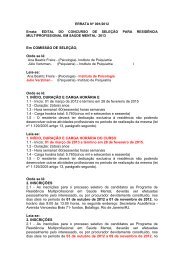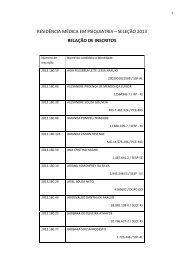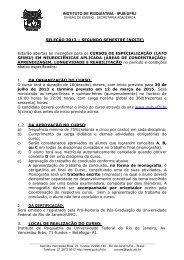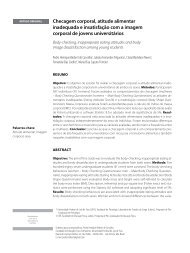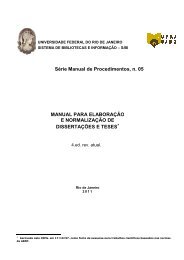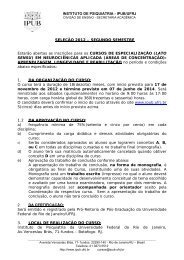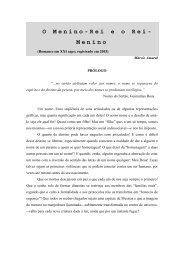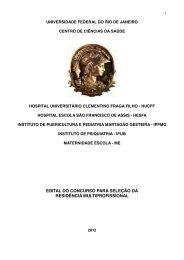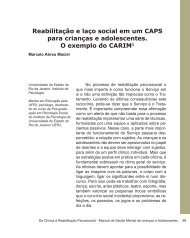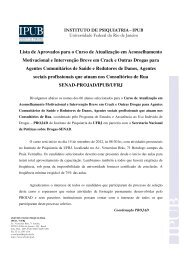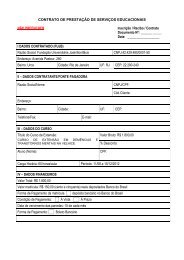Originais â Originals outubro | dezembro ⢠2011 - IPUB - UFRJ
Originais â Originals outubro | dezembro ⢠2011 - IPUB - UFRJ
Originais â Originals outubro | dezembro ⢠2011 - IPUB - UFRJ
Create successful ePaper yourself
Turn your PDF publications into a flip-book with our unique Google optimized e-Paper software.
302 King ALS et al.<br />
ORIGINAL ARTICLE<br />
INTRODUCTION<br />
Panic disorder (PD) 1 is characterized by the presence of frequent<br />
and recurrent acute attacks of anxiety, followed by<br />
physical and cognitive symptoms originating from mistaken<br />
associations of body sensations (BS) related to a premonition<br />
of something serious or of some potential illness. According to<br />
the cognitive theory 2 , due to this cognitive distortion, the individual<br />
assumes a badly adapted level of behaviour and loses<br />
the capability of identifying BS as natural forms of reactions<br />
stemming from the physiological mechanisms of adaptation 3 .<br />
We hypothesized that patients with panic disorder may<br />
reduce their number of panic attacks after the cognitive behavioural<br />
therapy (CBT) 4 sessions with symptom induction<br />
exercises (SIE) 5 and can also learn to deal with the cardiorespiratory<br />
symptoms such as tachycardia and abnormal<br />
breathing.<br />
Individuals with PD fear BS, and frequently suffer from<br />
panic attacks 6 (PAs) in certain stressful situations. PAs are described<br />
as traumatic, aggressive, and unpredictable.<br />
CBT 4 has the characteristic of being a short and well<br />
recom mended type of psychotherapy for the treatment<br />
of PD. Its methods include psycho education (educational<br />
techniques for the individual to learn to deal with anxiety<br />
and ample knowledge by the patient of the disorder in question),<br />
respiratory re-education (RR) exercises; progressive<br />
muscular relaxation (PMR) and cognitive restructuring (CR),<br />
which consists of giving a new meaning to the mistaken<br />
thought levels, are procedures of great importance in CBT.<br />
Finally, Interceptive exposure (IE) techniques have the objective<br />
of correcting catastrophic interpretations of the physical<br />
symptoms (bodily sensations) experienced by the patient. In<br />
vivo exposure (IVE) of the individual to feared places or situations<br />
is considered to be the primary intervention applied<br />
in the treatment, so that the patient with PD can overcome<br />
agoraphobic avoidance 7 .<br />
During the patient’s treatment, the techniques of IE<br />
and IVE are intended to interact to assist in the remission of<br />
the components of cognitive dysfunctions that are linked<br />
to agora phobic avoidance and to autonomic symptoms<br />
verified in PD. According to Rangé 8 , CBT is very efficient<br />
when compared to placebo, psychopharmacological treatments<br />
9,10 , and other forms of psychotherapy. However, some<br />
studies 11,12 have shown a good clinical response of panic disorder<br />
only to psychopharmacological treatment.<br />
IE and IVE can be administered by means of SIE and personal<br />
contact of the person with places and situations that<br />
the person has specifically defined as stressful. The successful<br />
overcoming of the initial stages of the treatment by the<br />
patient is required for the success of the subsequent steps.<br />
From the application of these exposures, the patient builds<br />
new internal defences that make him or her capable of staying<br />
naturally in prolonged contact with their own BS.<br />
The objective of this study is to compare PD patients<br />
treated with CBT associated with antipanic medication and<br />
patients treated only with antipanic medication and observe<br />
the evolution of cardio-respiratory symptoms in both groups.<br />
METHODOLOGY<br />
Patient selection<br />
For inclusion in the research the criteria adopted was, patients<br />
over 18 years old of both sexes with a diagnosis of PD<br />
with agoraphobia and no serious comorbidities. Patients<br />
that showed alcohol or drug dependency, mental retard, or<br />
serious mental disorders were excluded from the study. The<br />
randomized controlled trials were undertaken at the Panic<br />
and Respiration Laboratory (LABPR) at the Psychiatry Institute<br />
(<strong>IPUB</strong>) of the Federal University of Rio de Janeiro (<strong>UFRJ</strong>)<br />
and National Institute of Technologic Science – Translational<br />
Medicine (INCT-TM).<br />
All patients who agreed to participate in the study signed<br />
a “Term of Free and Clarified Consent” and were made aware<br />
of all the procedures to be undertaken, as approved by the<br />
Committee of Ethics for the research <strong>IPUB</strong>/<strong>UFRJ</strong>.<br />
Patients with PD with agoraphobia were diagnosed by<br />
clinical psychiatrists from the team at the LABPR/<strong>IPUB</strong>/<strong>UFRJ</strong>,<br />
according to the diagnostic criteria of the Manual of Diagnostic<br />
and Statistics of Mental Disorder 1 and the Structured<br />
Clinical Interview Diagnostic (SCID-I) evaluation instrument 13 .<br />
The sample consisted of 50 voluntary patients divided<br />
into two groups by means of a random draw. The first group<br />
(n = 25) received 10 sessions of CBT in conjunction with<br />
pharmacotherapy. The second group, the control group (n<br />
= 25), received only medication. The patients started on concomitant<br />
medication and CBT.<br />
We found that there was no loss in the sample. Fifty two<br />
volunteers were evaluated in the total survey. Of all the study<br />
volunteers, only two dropped out. We noted that all the remaining<br />
volunteers felt welcome and receptive to the study<br />
from the beginning and therefore continued till the end.<br />
Of the two who dropped out, one was due to travel and<br />
the other just dropped without any explanation. The raters<br />
were blind to refer patients to one group or another.<br />
Variables before and after treatment were collected by<br />
the same psychologist evaluator with training in cognitive<br />
behavioural therapy, the same professional also implemented<br />
all the scales and questionnaires. This professional psychologist<br />
received supervision from a multidisciplinary team<br />
from the LABPR/<strong>IPUB</strong>/<strong>UFRJ</strong>.<br />
Patient evaluation<br />
With a view to comparing the results of the groups after the<br />
interventions, the following evaluation instruments were ap-<br />
J Bras Psiquiatr. <strong>2011</strong>;60(4):301-8.




